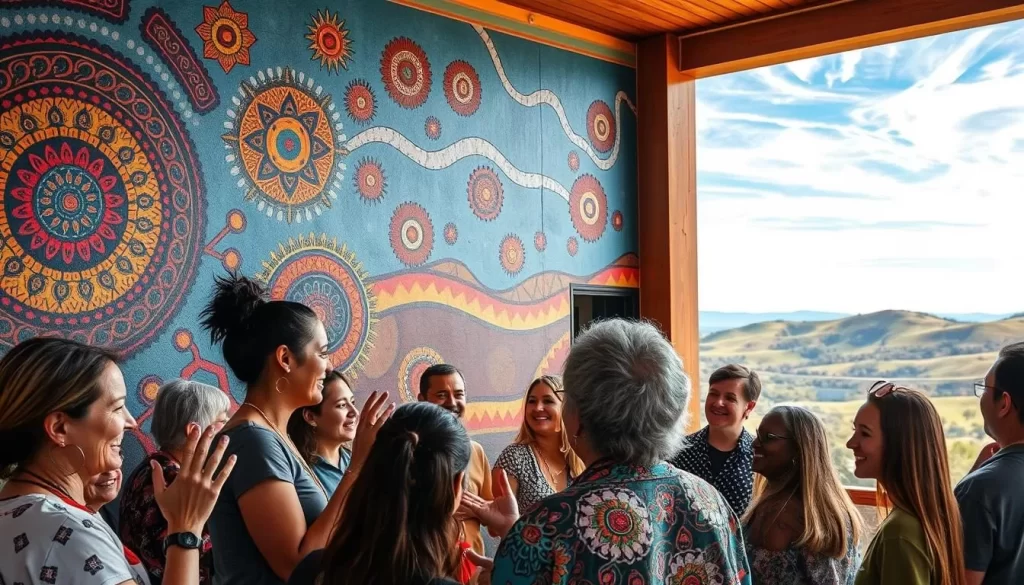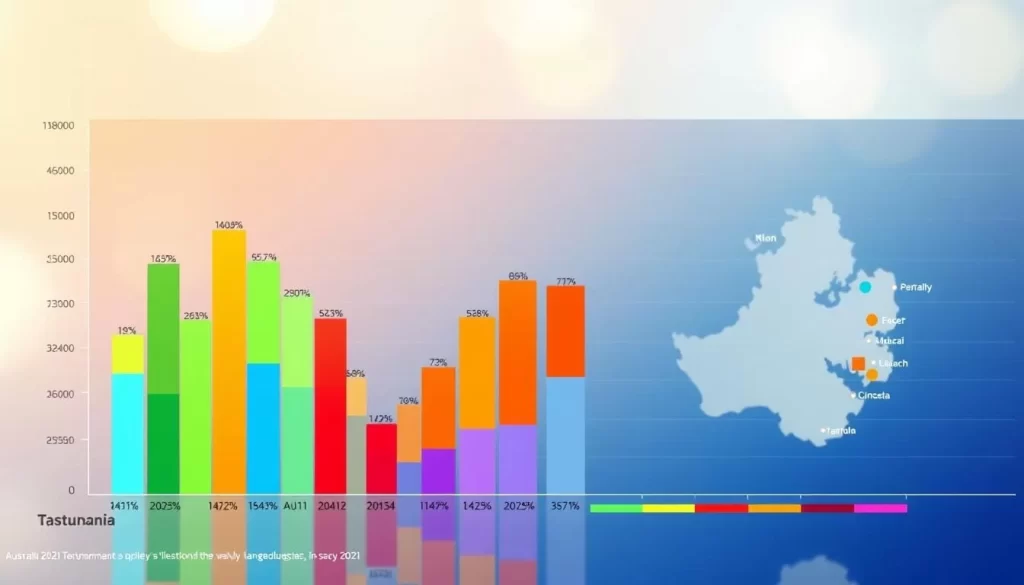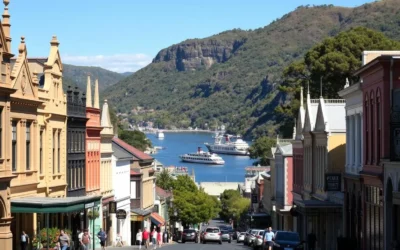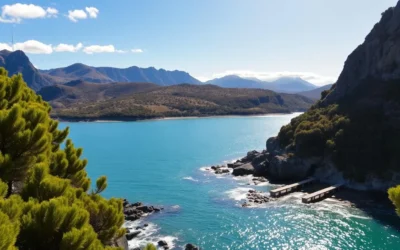✓ Accommodations✓ Flights✓ Rental Cars
Have you ever wondered about the language diversity in a unique state surrounded by water? This region, home to a rich cultural history, has seen a fascinating evolution in its linguistic landscape. From historical records, itMulticultural Action Plan’s clear that multiple distinct languages were once spoken here, reflecting the vibrant traditions of its indigenous communities.
One of the most notable figures in this history is Fanny Cochrane Smith, the last known speaker of a native language. Her recordings, made over a century ago, mark the end of an era and serve as a vital connection to the past. Today, efforts like the Palawa kani project aim to revive and preserve these lost dialects, ensuring they remain a part of the cultural fabric.
With a population of over 570,000, this area continues to embrace its diverse heritage. The 2021 census highlights the growing influence of immigrant communities, adding new layers to the linguistic tapestry. Whether you’re a history enthusiast or simply curious, exploring this region’s language story offers a glimpse into its enduring legacy.
Historical Linguistic Heritage of Tasmania
Long before European settlement, this area was home to a vibrant array of indigenous languages. These dialects were deeply tied to the land, reflecting the cultural and spiritual connections of the Aboriginal peoples. Linguists estimate that between 8 and 12 distinct languages were spoken here before the arrival of Europeans.
Early documentation of these languages was crucial in preserving their legacy. George Augustus Robinson, a key figure in the 19th century, recorded over 4,500 words during his travels between 1829 and 1834. His work, along with contributions from researchers like Joseph Milligan, provides a valuable glimpse into the linguistic diversity of the time.
Aboriginal Roots and Early Language Use
The Aboriginal peoples of this region used language not just for communication but as a way to pass down traditions and knowledge. Historical records show that these dialects were often mutually unintelligible, highlighting the complexity of the linguistic landscape.
Despite the challenges posed by European settlement, efforts to document and preserve these languages have continued. Fanny Cochrane Smith, the last known speaker of a native dialect, left behind recordings from the late 19th century, offering a rare auditory connection to the past.
Evolution from Pre-European Times
Before European arrival, this region was a hub of linguistic diversity. The indigenous population, estimated at 4,000, spoke a variety of dialects that reflected their unique cultural identities. Over time, the impact of colonization led to a significant decline in both the population and the use of these languages.
Today, historical linguistic evidence helps us understand the evolution of these dialects. Projects like the Palawa kani revival initiative aim to reconnect modern communities with their linguistic heritage, ensuring these languages remain a vital part of the cultural fabric.
Tasmanian Language Revival and the Palawa Kani Project
The revival of indigenous languages is a powerful movement reshaping cultural identity. In this region, the Palawa kani project stands as a beacon of hope, reconnecting communities with their linguistic heritage. This initiative, led by the Tasmanian Aboriginal Centre, has been active since the early 1990s and continues to grow.

Modern Revival Efforts
Modern technology and community collaboration have played a key role in reviving lost dialects. The Palawa kani project has collected over 200 words, phrases, and song fragments from the memories of Aboriginal people. This effort has helped reconstruct vocabulary from 8 to 16 original languages, ensuring their survival for future generations.
Linguistic research in the 1990s confirmed specific sounds in the original languages, leading to the creation of a custom alphabet. Today, this project continues to evolve, integrating grammatical structures and adapting traditional words to describe modern concepts.
Community Engagement and Cultural Impact
Community workshops have been instrumental in shaping the Palawa kani project. Participants in the 1990s acknowledged that remnants of original languages were insufficient to revive any single dialect, leading to the creation of a composite language. This approach has allowed for broader cultural engagement and educational opportunities.
The reintroduction of a common language has strengthened cultural identity among Aboriginal communities. For example, the first song in Palawa kani was released in 2014, and the language has since been featured in films, television shows, and public advertisements.
Government policies have also supported these efforts, ensuring resources are available for language revitalization. Dual names for landmarks, such as Mt Wellington (kunanyi), reflect the growing recognition of this linguistic heritage.
The Role of the Flinders Island Lingua Franca
The story of Flinders Island’s linguistic evolution is a testament to resilience and adaptation. After colonization, the island became a melting pot where a common language emerged among the displaced communities. This lingua franca served as a bridge, connecting people from diverse backgrounds during a challenging time.
Fanny Cochrane Smith, a remarkable person in this history, played a pivotal role in preserving this linguistic heritage. Born in 1834, she was the last fluent speaker of the Flinders Island lingua franca. Her wax cylinder recordings, made in 1899, are the only surviving audio of any indigenous language from the region.
Legacy of Fanny Cochrane Smith
Fanny’s recordings are more than just historical artifacts; they are a source of cultural pride. Her songs, captured on wax cylinders, offer a rare auditory glimpse into the past. These recordings have become a cornerstone for modern language revival projects, inspiring efforts like the Palawa kani initiative.
Her legacy extends beyond her recordings. Fanny was granted 300 acres of land by the government in 1889, recognizing her as the last “full-blooded” Tasmanian Aboriginal person. This acknowledgment highlights her importance in preserving the cultural identity of her people.
The historical circumstances that fostered a common language on Flinders Island are a fascinating example of adaptation. Despite the challenges of colonization, the island’s unique position in Bass Strait allowed for the development of a shared linguistic form. This adaptability continues to influence modern efforts to revive and preserve indigenous languages.
Understanding Tasmanian Aboriginal Languages
Exploring the linguistic roots of this region reveals a rich tapestry of ancient dialects. Before European disruption, the area was home to several distinct language families. These languages were deeply intertwined with the cultural and spiritual practices of the Aboriginal peoples.

Language Families and Word Lists
Linguists estimate that between 8 and 12 different languages were spoken by Tasmanian Aboriginal people prior to invasion. George Augustus Robinson documented over 4,500 words during his travels between 1829 and 1834, providing a valuable source for understanding these languages.
Word lists compiled by researchers like Schmidt, Dixon, and Crowley have been crucial in classifying these languages. These lists offer insights into the structure and vocabulary of the dialects, helping to reconstruct their forms and uses.
Phonological and Grammatical Features
Phonological studies have identified unique sounds and patterns in Tasmanian Aboriginal languages. For example, the use of specific consonants and vowels distinguishes these dialects from others in the region.
Grammatical features, such as verb conjugations and noun cases, also highlight the complexity of these languages. Scholars have used these features to trace the evolution of language families over time.
| Language Family | Key Features | Examples |
|---|---|---|
| Eastern Tasmanian | Unique vowel patterns | yolla (short-tailed shearwaters) |
| Western Tasmanian | Complex verb forms | nipaluna (Hobart) |
Understanding these linguistic details helps us appreciate the diversity and richness of the Tasmanian Aboriginal languages. This knowledge also supports ongoing efforts to revive and preserve these important cultural forms.
Tasmania, Australia: Official and widely spoken languages
Government policies play a vital role in shaping the linguistic landscape of any region. In this area, efforts to preserve and promote indigenous languages have gained momentum in recent years. The government has implemented various initiatives to support linguistic revitalization, ensuring these languages remain a part of the cultural fabric.
One key initiative is the integration of indigenous languages into educational curricula. Schools now offer programs that teach these languages, helping younger generations connect with their heritage. This approach not only preserves the language but also strengthens cultural identity.
Educational Services and Community Engagement
Community workshops and language classes have been instrumental in these efforts. These programs provide resources for people to learn and practice indigenous languages. They also foster a sense of pride and belonging among participants.
Legislative measures have further supported these initiatives. For example, dual naming of landmarks, such as kunanyi (Mt Wellington), reflects the growing recognition of indigenous heritage. This policy ensures that traditional names are used alongside modern ones.
Historical and Modern Connections
Modern policies build on historical efforts to document and preserve languages. Early records, like those of George Augustus Robinson, have been invaluable in reconstructing lost dialects. Today, these records guide contemporary revival projects.
The government also collaborates with local communities to ensure policies align with their needs. This partnership has led to successful programs, such as the Palawa kani project, which has revived and adapted traditional words for modern use.
By combining historical knowledge with modern strategies, these initiatives ensure that indigenous languages continue to thrive. They serve as a bridge between the past and the future, preserving a vital part of the region’s identity.
Impact of 2021 Census Data on Language Demography
The 2021 Census provides a detailed snapshot of how language use is evolving in this region. It highlights significant demographic shifts and offers insights into the changing linguistic landscape. Understanding these trends helps us see how the population influences the prevalence of different languages.

Recent Demographic Shifts and Trends
The census data reveals a notable increase in the number of people speaking languages other than English at home. Immigrant communities from England, China, Nepal, and India have contributed to this diversity. For example, Mandarin remains the most common non-English language, spoken by 685,274 people.
This shift is also reflected in the percentage of residents born overseas, which now stands at 27.6%. Such changes highlight the growing multicultural identity of the region and its impact on everyday communication.
Population Insights and Language Usage
The median age of the population has remained steady at 38 years, but younger generations are increasingly embracing multilingualism. Generation Z, for instance, represents 18% of the total population, with many speaking languages other than English at home.
These insights are crucial for government planning. By understanding the scope of language usage, policymakers can better allocate resources for educational programs and community services. This ensures that linguistic diversity remains a vital part of the region’s cultural fabric.
Influence of Colonial History on Language Development
The colonial era brought profound changes to the linguistic identity of this region. Before European settlement, indigenous communities thrived with a rich tapestry of dialects. However, the arrival of colonizers in the late 18th century marked the beginning of a dramatic shift.
Forced removals and assimilation policies severely impacted language diversity. Many indigenous people were relocated to government settlements, disrupting their cultural practices. This led to the rapid decline of original dialects, with fewer than 10% of Aboriginal people speaking a traditional language today.
European settlement also gave rise to mixed languages, such as the Bass Strait pidgin. This common language emerged as a way for displaced communities to communicate. It became a vital bridge during a challenging time, blending elements of indigenous and European speech.
Historical records show that over 250 distinct indigenous languages existed before colonization. By the 19th century, many of these were classified as endangered. Today, only 18 languages are spoken by all generations, highlighting the lasting impact of colonial policies.
Government actions played a significant role in this transformation. Settlements and cultural reorganization prioritized European norms, often at the expense of indigenous traditions. This not only affected the state’s linguistic landscape but also its broader cultural identity.
Understanding this history helps us appreciate the resilience of indigenous communities. Despite the challenges, efforts to revive and preserve these languages continue, ensuring they remain a vital part of the region’s heritage.
Comparing Traditional and Modern Language Use in Tasmania
Language use in this region varies significantly between rural and urban settings. In rural areas, traditional dialects often hold a stronger presence, deeply tied to community identity and heritage. Urban centers, on the other hand, reflect a more modern adoption of languages influenced by migration and global communication trends.

In rural settlements, community identity plays a vital role in preserving traditional language forms. These areas often maintain a closer connection to indigenous roots, with initiatives like the Palawa kani project gaining traction. For example, remote coastal communities have been more successful in integrating traditional words into daily life compared to urban hubs.
Urban centers like Hobart showcase a different dynamic. Here, the influence of migration has led to a rise in multilingualism. The 2021 census highlights that 86.1% of the population in this state speaks only English at home, a decrease from 91.7% in 2011. This shift reflects the growing diversity in urban areas, where languages like Mandarin and Nepali are increasingly common.
The government has played a crucial role in shaping these trends. Policies supporting language education and community workshops vary by region, with rural areas often receiving more targeted support for traditional language preservation. Urban initiatives, meanwhile, focus on integrating immigrant languages into public services and schools.
“The way we speak connects us to our past and shapes our future. Preserving traditional languages is not just about words; it’s about identity.”
Modern communication tools have also influenced language continuity. In urban settings, digital platforms have made it easier for immigrant communities to maintain their native languages. Rural areas, however, face challenges in accessing such resources, which can hinder language preservation efforts.
Understanding these differences helps us appreciate the complexity of the linguistic landscape. Whether in rural or urban settings, language remains a powerful tool for cultural expression and connection. For more insights into how migration shapes language patterns, explore this detailed study.
Multilingual Dynamics in Tasmania
The linguistic landscape of this state reflects a vibrant mix of cultures and traditions. Over 300 languages are spoken across the region, showcasing its multicultural identity. This diversity is a testament to the global influences shaping the area’s communication patterns.
Immigrant Languages and Global Influences
Immigration has introduced a variety of languages from around the world. Mandarin, for example, is the second most commonly spoken language, with over 2% of residents listing it as their first language. Other prominent languages include Nepali, Punjabi, and Spanish, each adding to the region’s rich linguistic tapestry.
The 2021 census highlights a significant increase in non-English language usage. This shift reflects the growing influence of immigrant communities, who bring their unique cultural and linguistic heritage. These languages coexist with English, creating a dynamic and inclusive environment.
Global trends also play a role in shaping local language policies. The government has implemented initiatives to support multilingualism, ensuring accessibility for all residents.
“Language is the road map of a culture. It tells you where its people come from and where they are going.”
Understanding these multilingual dynamics helps us appreciate the region’s cultural richness. Whether through education or community programs, the integration of diverse languages strengthens the social fabric and fosters unity.
Cultural Diversity and Language in Tasmanian Society
Cultural diversity shapes the heart of this region’s identity. From ancient traditions to modern influences, the voices of many cultures weave a unique linguistic tapestry. This area is home to people born in 177 different countries, with 159 languages spoken in homes. Such diversity highlights the importance of preserving and celebrating these voices.
Aboriginal and Torres Strait Islander Contributions
The tasmanian aboriginal and torres strait islander communities play a vital role in this linguistic landscape. Their languages and traditions are a source of cultural pride and resilience. Efforts like the Palawa kani project aim to revive and preserve these dialects, ensuring they remain a part of the region’s heritage.
According to the 2016 Census, more than 61,200 residents were born overseas, adding to the multicultural fabric. This blend of voices enriches the community, fostering a sense of unity and respect for all cultures.
Community Initiatives and Multilingualism
Community initiatives are key to promoting multilingualism. Programs like language classes and cultural workshops help residents connect with their heritage. The government supports these efforts through policies that encourage inclusivity and accessibility.
“Language is the road map of a culture. It tells you where its people come from and where they are going.”
For example, over 90% of survey participants agreed that accepting people from many different countries makes this state stronger. Such initiatives ensure that language diversity remains a cornerstone of modern identity.
To learn more about these efforts, explore the Multicultural Action Plan, which outlines strategies for fostering an inclusive society.
Technological Advances in Preserving Tasmanian Languages
Modern technology is reshaping how we preserve and teach endangered languages. Digital tools are playing a crucial role in safeguarding linguistic heritage, especially for indigenous dialects. From virtual archives to online learning platforms, these innovations are ensuring that languages remain alive for future generations.
Digital Archives and Their Role
Digital archives are a game-changer for preserving endangered languages. They store recordings, documents, and other materials that might otherwise be lost. For example, over 50,000 hours of audio have been recorded for transcription and preservation, ensuring that these voices are not forgotten.
These archives also make it easier for researchers and communities to access valuable resources. Traditional transcription methods, which could take millions of hours, are now streamlined with advanced technology. This increase in efficiency helps accelerate language revival efforts.
Educational Resources and Online Platforms
Technology is also transforming how languages are taught. Online platforms and apps provide accessible resources for learners of all ages. For instance, the ARC Centre of Excellence for the Dynamics of Language has built models for 12 indigenous languages, making them easier to study and teach.
Community workshops and digital tools like language-learning robots are enhancing educational experiences. These innovations ensure that languages are not just preserved but actively used in daily life.
| Technology | Application | Impact |
|---|---|---|
| Digital Archives | Storing recordings and documents | Preserves endangered languages |
| Online Platforms | Language learning apps | Makes education accessible |
| Robotics | Interactive language practice | Engages younger learners |
These advancements highlight the importance of technological innovation in language preservation. By combining historical knowledge with modern tools, we can ensure that linguistic diversity remains a vital part of our world. For more insights, explore this detailed study on linguistic diversity and preservation.
Tasmania’s Language Landscape and Government Services
Effective language policies are essential for fostering inclusivity and cultural preservation in any community. In this state, the government has taken significant steps to integrate these policies into public administration and education. These efforts ensure that everyone, regardless of their linguistic background, has access to essential services.
Language in Public Administration and Education
One key initiative is the incorporation of indigenous languages into school curricula. This approach not only preserves cultural heritage but also strengthens community identity. For example, programs teaching traditional dialects have been introduced in schools, helping younger generations connect with their roots.
Public administration has also embraced multilingualism. Government offices now provide documents and services in multiple languages, ensuring accessibility for all residents. This policy reflects the growing diversity of the population and the need for inclusive practices.
Service Accessibility and Community Outreach
Community outreach programs play a vital role in promoting language accessibility. Workshops and language classes are regularly organized to help residents learn and practice indigenous dialects. These initiatives foster a sense of pride and belonging among participants.
Collaborative efforts between the government and local communities have been instrumental in these programs. For instance, dual naming of landmarks, such as kunanyi (Mt Wellington), reflects the growing recognition of indigenous heritage. This approach ensures that traditional names are used alongside modern ones.
“Language is not just a tool for communication; it’s a bridge that connects us to our culture and history.”
By integrating language initiatives into administrative practices, this state ensures that its diverse heritage remains a vital part of its identity. These efforts highlight the importance of collaboration and inclusivity in preserving cultural traditions.
Informative Resources and Further Reading
Exploring the rich linguistic heritage of this region offers a deeper understanding of its cultural roots. To help you dive deeper, here’s a curated list of resources, including academic studies, government publications, and digital archives.
For those interested in indigenous languages, the AIATSIS website is an excellent starting point. It provides detailed insights into over 250 Indigenous languages and dialects, highlighting their cultural significance.
Academic studies are invaluable for understanding the evolution of these languages. The University of Tasmania offers a Diploma of Languages, which includes courses on indigenous dialects. This program can be completed in 3 to 7 years, offering flexibility for learners.
Government publications also play a crucial role in preserving linguistic heritage. The 2021 census data reveals significant shifts in language usage, with Mandarin being the second most spoken language at home. This data is essential for understanding current trends.
Digital archives, such as the Living Archive of Aboriginal Languages, provide access to endangered literature. These resources are vital for researchers and anyone interested in linguistic preservation.
| Resource | Description | Link |
|---|---|---|
| AIATSIS | Comprehensive guide to Indigenous languages | AIATSIS |
| University of Tasmania | Diploma of Languages program | UTAS |
| 2021 Census Data | Insights into language usage trends | ABS |
| Living Archive | Digital archive of endangered literature | Living Archive |
These resources not only preserve the language but also strengthen cultural identity. By exploring them, you can gain a deeper appreciation for the region’s linguistic diversity.
“Language is the road map of a culture. It tells you where its people come from and where they are going.”
For more detailed studies, consider exploring academic papers and government reports. These materials provide a wealth of information for anyone passionate about linguistic heritage.
Conclusion
Language connects us to our past and shapes our future. This state’s linguistic heritage reflects a rich tapestry of cultural identity, from ancient dialects to modern multilingualism. Efforts like the Palawa kani project are vital in reviving and preserving these voices, ensuring they remain a part of the cultural fabric.
The government has played a key role in shaping this landscape. Policies supporting language education and community initiatives have strengthened cultural pride. Recent census data highlights the growing diversity of the population, with languages like Mandarin gaining prominence.
Understanding this history offers a glimpse into the resilience of communities. By exploring further resources and engaging with local initiatives, you can contribute to preserving this unique heritage. Let’s celebrate the voices that connect us to the world and each other.
The above is subject to change.
Check back often to TRAVEL.COM for the latest travel tips and deals.






